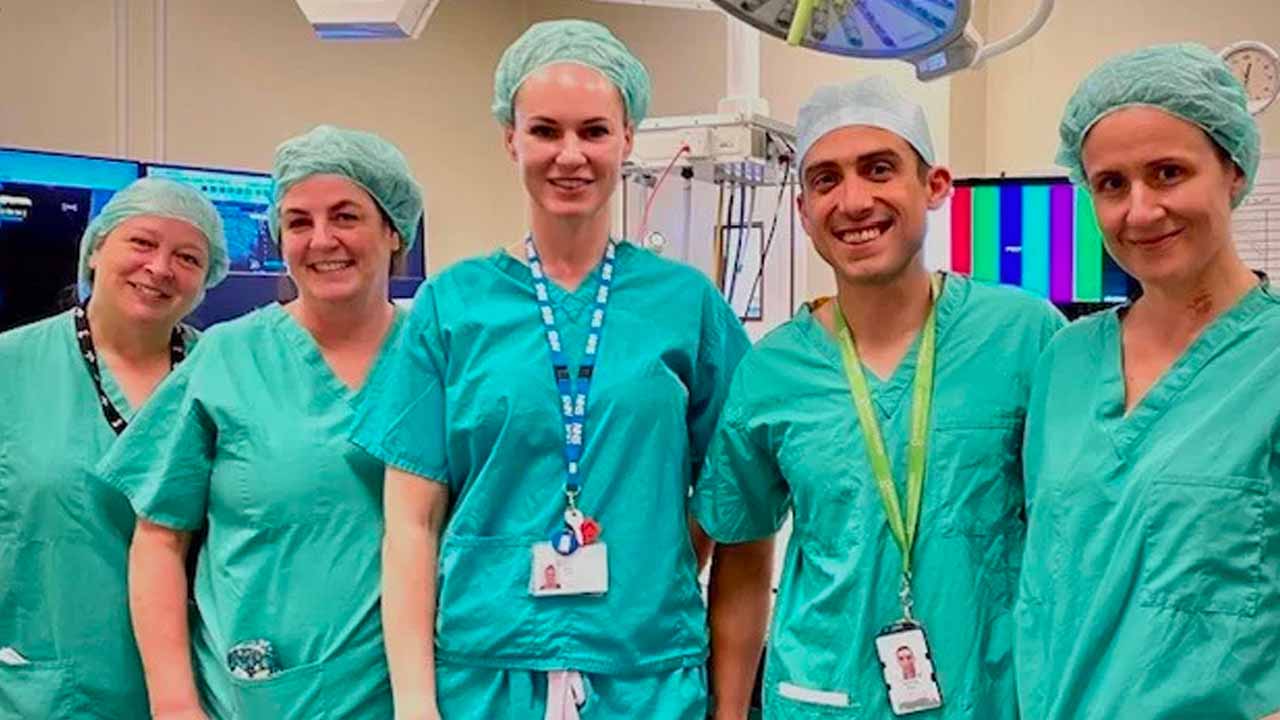Breast Conserving Surgery (Lumpectomy)
-
 Mr Andrew Pieri
Mr Andrew Pieri - Updated July 16, 2024
- Created July 6, 2022
What Is A Lumpectomy?
A lumpectomy, also known more accurately as a wide local excision, is the most basic form of breast conserving surgery (BCS). BCS is an umbrella term that covers any form of surgical procedure used to remove a cancerous breast lesion without performing a mastectomy.
For a lumpectomy, the surgeon removes the cancer cells from the breast, trying to conserve as much of the unaffected breast tissue as possible. In some cases, axillary lymph node dissection can be performed at the same time as a lumpectomy to check for further cancer cells.
If the area of breast tissue is less than around 20% of the total breast volume, then usually, the surrounding breast tissue can be sutured together to close the cavity in the breast. This approach will help to avoid any significant cosmetic defect without a more technical plastic surgery type of procedure being required.
If the specimen is larger than 20% of the total breast size, then often a more complicated onco-plastic procedure is required, employing either a volume ‘displacement’ or a volume ‘replacement’ technique.
After the block of tissue is removed, it is sent to the lab for microscopic assessment to check if further treatment is needed.
Radiation therapy is then provided after the lumpectomy to eradicate all the cancer cells, with the aim of leaving the patient with no remaining breast cancer cells.
When A Lumpectomy Can Be Performed
A lumpectomy is recommended for patients whose cancer is small compared to their breast size and is only in one area of their breast. If this is the case, then a lumpectomy could be an ideal form of treatment for invasive breast cancer.
After a lumpectomy, radiotherapy is usually carried out to remove all remaining cancer cells from the breast. For most patients, particularly those who had early stage breast cancer treatment, the lumpectomy is the final surgical treatment, and there will be no need for more surgery to stop the cancer from coming back.
However, all breast cancer patients will then receive regular checks for the rest of their lives, and if local recurrence occurs, their surgical team can explore further treatment options and more breast surgery.


When A Lumpectomy Can't Be Performed
For some cancer patients, a lumpectomy isn’t the best course of treatment. There are several reasons this might be the case, particularly if radiotherapy cannot be performed afterwards. Radiation therapy can only be provided to one part of the body in a lifetime, so patients who have had breast cancer in the past may not be able to have a lumpectomy.
Genetics also plays a part, as some patients have a genetic predisposition to developing breast cancers, such as patients with BRCA1, BRCA2, PALB2 and TP53 gene mutations. Patients at higher risk of developing breast cancer often opt for a full breast removal to reduce the risk of future breast cancers, even when a lumpectomy might be a perfectly viable option for treating their current breast cancer.
Also, the breast surgeon has to consider the size of the breast cancer tumour compared to the healthy breast tissue. Using advanced plastic surgery techniques, modern oncoplastic breast surgeons can remove larger tumours from smaller breasts without performing a mastectomy. Nonetheless, sometimes, there are just no plastic surgery procedures that suit the situation, and a mastectomy (with or without simultaneous reconstruction) is required.
Other Types Of Breast Conserving Surgery
If a lumpectomy cannot be performed, there are several other types of BCS to consider before a mastectomy.
The one that works best will depend on a variety of factors, including the size of the tumour and the patient’s personal preferences.
While all other more complicated breast conserving procedures are essentially variations on a theme, there are several other options patients can choose from, including:
Therapeutic Mammoplasty
A mammoplasty is the medical term used to describe a breast reduction procedure.
Prefixed by ‘therapeutic’, this describes a breast reduction procedure designed such that the tissue removed to reduce the breast size contains the wide local excision of the breast lesion. There are almost infinite variations on how to perform this procedure, including Wise pattern, Batwing, Vertical and Benelli, to name a few.
The choice of method is based on a combination of factors, including the breast size and shape, the tumour location in the breast, the patient’s risk factors for wound problems and the surgeon’s preference. Usually, the same procedure is performed on the other breast for cosmetic symmetry.
Some of the breast skin is also removed in most techniques to provide an uplift as well as breast volume reduction. Therapeutic mammoplasty is an example of a volume ‘displacement’ procedure, where the remaining native breast tissue is displaced or reshaped to form a new, smaller breast.
Volume Replacement Flaps
These are examples of pedicled flaps, where the tissue’s original blood supply is kept intact, as opposed to a free flap where the donor tissue is plumbed in (anastomosed) to the native vessels.
These volume replacement flaps tend to be named after their blood vessels, e.g. LTAP (lateral thoracic artery perforator), TDAP (thoracodorsal artery perforator), LICAP (lateral intercostal artery perforator), MICAP (medial intercostal artery perforator), etc.
This option is considered to have a better cosmetic outcome and a higher rate of patient satisfaction than other breast surgery procedures and can create a natural breast shape.
For More Information On Breast Conserving Surgery
To find out more about breast conserving surgery, including lumpectomies and other breast cancer surgery options, visit breastcancer.org or the NHS website.
It’s important you get your advice from reputable sources, and for a discussion about your specific breast cancer treatment options, you need to speak to someone who specialises in breast cancer surgery.
If you would like to discuss your situation with an experienced oncoplastic surgeon and establish what options are available to you, then arrange a consultation with Mr Pieri.
frequently asked questions
How Long Does A Lumpectomy Take?
A lumpectomy usually takes between 1 hour and 90 minutes and is considered a short outpatient procedure, meaning patients can recover at home. The procedure may take longer if the patient needs to have lymph nodes removed at the same time. Lymph node removal is done during the same procedure as the lumpectomy, which can mean that the procedure takes up to an hour longer.
Is A Lumpectomy Safer Than A Mastectomy?
Every patient is different, and there’s no definitive answer to this question. However, in the 1980s, research demonstrated that patients undergoing a mastectomy had no survival advantage over those having breast-conserving surgery. Additionally, the research found that if patients undergoing breast conserving surgery then received a course of radiotherapy to the remaining breast tissue after their operation, the recurrence rate is similar to that of a mastectomy. There has been further research carried out more recently that suggests that patients undergoing breast-conserving surgery and radiotherapy may actually have a lower risk of breast cancer recurrence than those having a mastectomy.
If More Tissue Needs To Be Removed, Is A Mastectomy The Only Option?
A lumpectomy is the simplest form of breast cancer removal, and there are several other BSC options available for patients who have more locally advanced breast cancer. There is a robust body of evidence demonstrating the benefits of breast conserving surgery compared to mastectomy with regard to long-term psychological morbidity. As a consequence, different techniques have been progressively developed in order to remove increasingly large areas of breast tissue without a mastectomy and still provide a good cosmetic result. This practice forms a large part of what is termed oncoplastic surgery for breast cancer treatment.
How Do Breast Surgeons Locate The Tumour?
When performing a lumpectomy, the tumour has to be located before it can be removed. In some cases, the tumour is palpable and can be felt, so locating the part of the breast that needs to be removed is straightforward. In other cases, the tumour cannot be felt and is impalpable, usually because it is deeper in the breast and the surrounding tissue cushions it. This is usually due to the tumour being diagnosed on a screening mammogram rather than the patient coming to the clinic with symptoms. In these cases, the tumour is localised by inserting a marker that can be detected during the operation and used to indicate the area to remove. Methods include using a wire, a radioactive seed, signal reflectors and radiofrequency tags to find the tumour.
What Are The Downsides To Breast Conserving Surgery?
Breast conserving therapy has many benefits for breast cancer patients, but it does also have downsides. The main ones are that you will need to have radiation therapy after the lumpectomy surgery, which is not usually required after a mastectomy. While most patients experience limited side effects of radiotherapy, it can cause issues. For these patients, often a mastectomy must be performed since breast conserving surgery is only equivalent to mastectomy in terms of prognosis if it is combined with postoperative radiotherapy. Also, in around 10-15% of cases, there are cancer cells seen extending to the edge of the specimen (i.e. a positive margin). In these cases, more surgery is required to take a shave of tissue from the breast cavity site.
Book Your Breast Conserving Surgery Consultation
If you would like to discuss your situation with an experienced oncoplastic surgeon and establish what options are available to you, then arrange a consultation with Mr Pieri.









